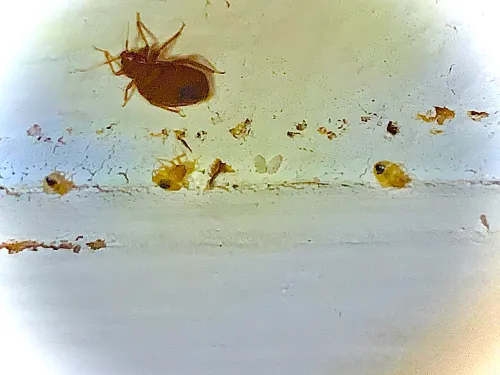Bed bugs, those pesky little insects that feed on blood, are notorious for causing discomfort and distress among homeowners. Typically, we associate bed bugs with hiding in mattresses, box springs, and cracks and crevices in furniture. However, have you ever wondered, “Why would bed bugs be on the ceiling?” In this article, we’ll delve into this intriguing question and explore the reasons behind this unexpected behavior.

Understanding Bed Bug Behavior
The Typical Hideouts
Bed bugs are known for their excellent hiding abilities. They prefer to stay close to their hosts (which are often humans) while remaining concealed during daylight hours. Common hiding spots for bed bugs include the seams and folds of mattresses, behind headboards, inside electrical outlets, and in the crevices of wooden furniture.
The Unusual Spot: Bed Bugs on the Ceiling
Exception to the Rule
While bed bugs typically gravitate toward the areas where their hosts sleep, there are situations where they may end up on the ceiling. Here are some reasons why bed bugs might find their way there:
1. Desperation for a Meal
Bed bugs feed on blood, and they can detect the carbon dioxide we exhale from our breath, which signals the presence of a potential meal. If they are unable to find a host on the bed or nearby furniture, they may crawl up the walls and ultimately end up on the ceiling in search of a blood meal.
2. Overcrowding
Bed bugs reproduce rapidly, and infestations can quickly become overcrowded. When there are too many bed bugs in one hiding spot, they may start spreading out to nearby areas, including the ceiling, in an attempt to find more space.
3. Traveling Bed Bugs
Bed bugs are excellent hitchhikers and can be unknowingly transported from one place to another. If an infestation is present in a room, bed bugs might crawl up walls and onto the ceiling, hoping to hitch a ride on a passerby, such as a person or a pet, and be transported to another location.
4. Seeking Cooler Temperatures
Bed bugs are sensitive to temperature and humidity. In some cases, if the temperature near their hiding spot becomes too warm or uncomfortable, they may move to a cooler spot, which could be the ceiling.
5. Seeking Safety from Pesticides
When bed bug infestations are treated with pesticides or other control methods, bed bugs may flee to less treated areas, such as the ceiling, in an attempt to escape the threat. This behavior can make them harder to eradicate.
Dealing with Bed Bugs on the Ceiling
Addressing the Issue
If you find bed bugs on your ceiling, it’s essential to take action promptly. Here are steps to address the issue:
- Professional Pest Control: Consider hiring a professional pest control expert who specializes in bed bug extermination. They have the knowledge and tools to effectively eliminate the infestation.
- Inspection: Carefully inspect the entire room to identify the extent of the infestation. Look for other hiding spots, such as cracks, crevices, and furniture.
- Washing and Heat Treatment: Launder all bedding, clothing, and curtains in hot water and dry them on the highest heat setting. This will kill any bed bugs and their eggs.
- Vacuuming: Thoroughly vacuum the room, including the ceiling, to remove any bed bugs. Dispose of the vacuum bag or clean the vacuum’s canister outside of your home.
- Sealing Cracks: Seal any cracks, gaps, or openings in the walls or ceiling to prevent bed bugs from moving between rooms.
Conclusion
While it may seem unusual to find bed bugs on the ceiling, these insects are adaptable and will seek out new hiding spots when necessary. If you encounter bed bugs in your home, it’s crucial to take swift action to address the infestation. Consulting a professional pest control expert is often the most effective way to eliminate bed bugs and prevent their return. Understanding their behavior and how they end up on the ceiling can aid in keeping your home bed bug-free.